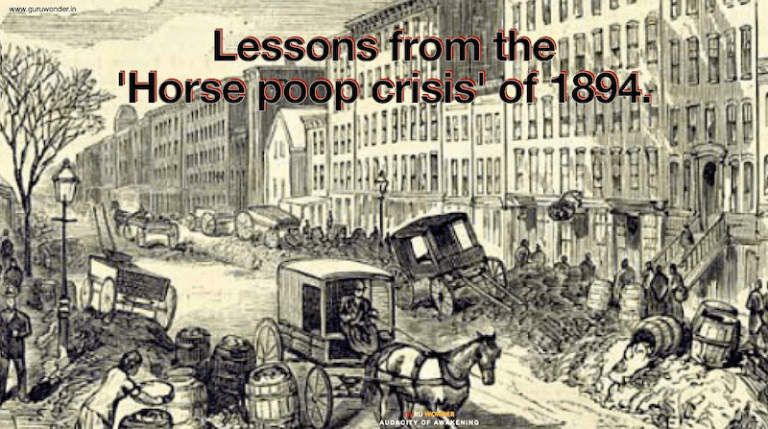![]()
By the late 1800s, large cities all around the world were “drowning in horse manure”.
In order, for these cities to function, they were dependent on thousands of horses for the transport of both people and goods.
In 1900, there were over 11,000 hansom cabs on the streets of London alone. There were also several thousand horse-drawn buses, each needing 12 horses per day, making a staggering total of over 50,000 horses transporting people around the city each day.
To add to this, there were yet more horse-drawn carts and drays delivering goods around what was then the largest city in the world with a population of 5 million inhabitants.
This huge number of horses created major problems.
The main concern was the large amount of manure left behind on the streets. On average a horse will produce between 6 and 14 kg of manure per day, so you can imagine the sheer scale of the problem. The manure on London’s streets also attracted huge numbers of flies which then spread typhoid fever and other diseases.

Each horse also produced around 2 litre of urine per day and to make things worse, the average life expectancy for a working horse was only around 3 years. Horse carcasses therefore also had to be removed from the streets. The bodies were often left to putrefy so the corpses could be more easily sawn into pieces for removal.
The streets of London were beginning to poison its people.
But this wasn’t just a British crisis: New York had a population of 100,000 horses producing around a million and a half kgs of manure a day.
This problem came to a head when in 1894, The Times newspaper predicted… “In 50 years, every street in London will be buried under nine feet of manure.”
This became known as the ‘Great Horse Manure Crisis of 1894’.
The terrible situation was debated in 1898 at the world’s first international urban planning conference in New York, but no solution could be found. It seemed urban civilisation was doomed.
However, necessity is the mother of invention, and the invention in this case was that of motor transport. Henry Ford came up with a process of building motor cars at affordable prices. Electric trams and motor buses appeared on the streets, replacing the horse-drawn buses.
By 1912, this seemingly insurmountable problem had been resolved; in cities all around the globe, horses had been replaced and now motorised vehicles were the main source of transport and carriage.
There are no solutions, just compromises. The automobile created another set of problems but that is another story.
Even today, in the face of a problem with no apparent solution, people often quote ‘The Great Horse Manure Crisis of 1894’, urging people not to despair, something will turn up!
There is no shortage of information or talking points about what is wrong.
The tragedy is that most people are waiting for someone else to set things right. At best, most of us complain, protest and show our concern by wringing our hands, but that will not change anything. Results come from action.
All is not hopeless, there are a small percentage of people who burn the midnight oil, roll up their sleeves, put their shoulder to the wheel and make things happen.
The question we have to ask ourselves is, are we talkers who only talk the talk or are we doers who walk the talk? Even if we can only talk, it’s best that we stand behind the doers and talk to support those who act positively.
Interesting Links:
-
Saving Bangalore, one lake at a time ~ Anand Malligavad at TEDx IIT Bangalore







